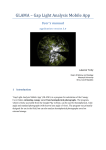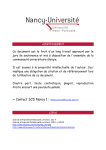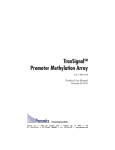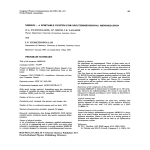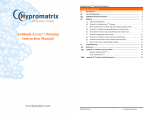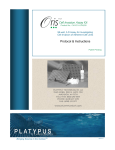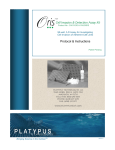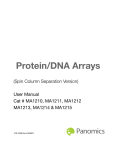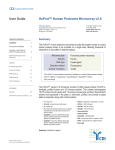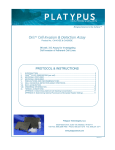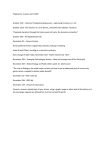Download TranSignal™ SH3 Domain Array - The Jena Protein
Transcript
TranSignal™ SH3 Domain Array Catalog No. MA3010 Product User Manual Version 1.1 Panomics Transcending boundaries... Panomics, Inc. • 2003 East Bayshore Road • Redwood City, CA 94063 • USA Tel: 650.216.9736 or 877.726.6642 (PANOMIC) • Fax: 650.216.9790 • www.panomics.com 2 TRANSIGNAL SH3 DOMAIN ARRAY CONTENTS 1. 2. 3. 4. 5. 6. 7. 8. 9. INTRODUCTION ............................................................................................. 3 MATERIALS PROVIDED ................................................................................... 6 ADDITIONAL MATERIALS REQUIRED ............................................................... 6 PREPARE BACTERIAL EXPRESSION CONSTRUCT ................................................ 7 PREPARE BACTERIAL EXTRACTS WITH SH3 LIGAND .......................................... 7 INCUBATION ................................................................................................. 8 WASH & DETECT ............................................................................................ 8 TROUBLESHOOTING ...................................................................................... 9 REFERENCES ............................................................................................... 10 APPENDIX A: TYPICAL RESULTS OF TRANSIGNAL SH3 DOMAIN ARRAY ................... 11 APPENDIX B: SCHEMATIC DIAGRAM OF THE TRANSIGNAL SH3 DOMAIN ARRAY ...... 11 APPENDIX C: MAP & MCS OF EXPRESSION VECTOR ............................................... 13 Trademarks, Patents, and Limited Warranty Panomics™ is a trademark of Panomics, Inc. SuperSignal™ is a trademark of Pierce. FluorChem™ is a trademark of Alpha Innotech Corporation. Hyperfilm™ is a trademark of Amersham Pharmacia Corporation. Certain aspects of the TRANSIGNAL array technology are in the process of patent filing. This product is intended for research purpose only. Panomics products may not be resold, modified for resale, or used to manufacture commercial products without written approval by Panomics, Inc. Panomics, Inc. warrants that the performance of this kit meet Panomics’ performance specifications from the time of shipment until the expiration date, if stored under the recommended conditions. Panomics disclaims all other warranties, either express or implied, including without limitation and implied merchantability or fitness for a particular purpose. Under no circumstances shall Panomics be liable for any damages arising out of the use of the materials. 2001–2 © Panomics, Inc. All rights reserved. (UM22302129) For Technical Support call 1.877.726.6642 (PANOMIC) or visit our website at www.panomics.com TRANSIGNAL SH3 DOMAIN ARRAY 1. INTRODUCTION One of the keys to understanding cellular signal transduction is clarifying how proteins interact with one another. Protein-protein interactions are often mediated by noncatalytic, conserved domains. One of these domains is the Src homology 3, or SH3, domain (1). SH3 Domain Structure & Function First identified as part of the Rous sarcoma oncogene product src, SH3 (src-homology-3) domains play an important role in intercellular communication and intracellular signal transduction. Each SH3 domain is a small, conserved sequence of about 60 amino acids that interacts with proline-rich binding sites. These sites, known as SH3 ligands, contain 6to-12 residues, with a conserved Pro-Xaa-Xaa-Pro (PXXP) motif (1). SH3 domains act as part of an adapter molecule, recruiting downstream proteins in a signaling pathway. SH3 domains mediate interactions in many key signaling pathways, including epidermal growth factor receptor signaling (2), cellular localization of cytoplasmic proteins (3), upregulation of GTPase activity of dynamin (4), and activation of phosphatidylinositol 3-kinase in response to IgM crosslinking (5). And SH3 domain activity has been implicated in both cancer and AIDS. Studying SH3 Domains As we near completion of the human genome project, new protein identities will emerge as will a growing need to study their functions. One way to characterize protein function is to identify which SH3 domain it binds to and hence unlock which signaling pathway it is involved with. In order to dissect signaling pathways that involve SH3 domains, scientists need a way to determine whether their ligand of interest interacts with SH3 domains—and, specifically, which SH3 domains bind to it. But this requires an assay that allows the SH3 domain to stay folded in its active conformation. Traditional methods for assaying protein-protein interactions, such as co-immunoprecipitation, are arduous and time consuming at best. For Technical Support call 1.877.726.6642 (PANOMIC) or visit our website at www.panomics.com 3 4 TRANSIGNAL SH3 DOMAIN ARRAY Observe protein interactions using all-in-one array system With the TranSignal™ SH3 Domain Array, you can determine whether your protein of interest binds to one or more of the 38 different SH3 domains—all in one experiment. The assay couldn’t be simpler: just express your protein of interest in bacteria and incubate the extract with the TranSignal SH3 Domain Array membrane. The protein interactions literally take place on the array membrane, and you can visualize them using chemiluminescent detection. We’ve spotted 38 of the most commonly studied SH3 domains on the TranSignal SH3 Domain Array. For a complete map of the array and list of SH3 domains, see the Appendix. For Technical Support call 1.877.726.6642 (PANOMIC) or visit our website at www.panomics.com TRANSIGNAL SH3 DOMAIN ARRAY Insert SH3 ligand of interest using ligand expression vector + = clone & express your protein of interest prepare bacterial extract incubate extract (or protein) with TranSignal™ SH3 Domain Array membrane chemiluminescence detection Signal strength corresponds to strength of protein-protein interaction Figure 1. Flow chart of the TranSignal™SH3 Domain Array procedure. For Technical Support call 1.877.726.6642 (PANOMIC) or visit our website at www.panomics.com 5 6 TRANSIGNAL SH3 DOMAIN ARRAY 2. MATERIALS PROVIDED • TranSignal SH3 Domain Array (2 each) • Positive Control Bacterial Extract (1.5 ml) (From E.Coli containing Class Ib Ligand from P13K) • pEXP Vector (Ligand expression vector, 10 µl; 0.08 µg/µl) • 20X Wash Buffer (2 x 60 ml) • 1X Resuspension Buffer (60 ml) 3. ADDITIONAL MATERIALS REQUIRED 3.1 Reagents and Solutions • DH5α α Competent Cells (Gibco BRL, Cat. No. 18265-017) • Penta-His Antibody, BSA-free (Qiagen, Cat. No. 34660) • Anti-Mouse IgG (Fab specific) Peroxidase (Sigma, Cat. No. A2304) • SuperSignal Elisa Pico Chemiluminescent Substrate (Pierce, Cat. No. 37070) • SuperBlock Blocking Buffer (Pierce, Cat. No. 37545) • LB w/Amp (Teknova, Cat. No. 0181-A100) (1.0% Tryptone, 0.5% yeast extract, 1.0% NaCl with 100 µg/ml ampicillin.) • IPTG (Teknova, Cat. No. 13307-50) 3.2 Materials and Equipment • Microcentrifuge • Sonicator • Small plastic tray or containers • Shaker • Hyperfilm ECL (Amersham, Cat.# RPN3114K) or equivalent OR • Chemiluminescence imaging system (e.g., FluorChem from Alpha Innotech Corp.) For Technical Support call 1.877.726.6642 (PANOMIC) or visit our website at www.panomics.com TRANSIGNAL SH3 DOMAIN ARRAY 4. PREPARE BACTERIAL EXPRESSION CONSTRUCT Using the Ligand Expression Vector (provided), insert the SH3 ligand of interest using standard molecular cloning techniques (6). For vector map, see Appendix B. Transform DH5α competent cells with DNA ligation mix as described by the manufacturer’s instructions. 5. PREPARE BACTERIAL EXTRACTS WITH SH3 LIGAND In this section, you will prepare bacterial extract containing your ligand of interest to hybridize with the array membrane (Section 6). 5.1 Inoculate the transformed bacteria in LB/Amp (100 µg/ml) (Section 4). 5.2 Grow bacteria overnight at 37°C with shaking (225 rpm). 5.3 Transfer 40 µl of overnight culture to a tube containing 4 ml of LB/ Amp (100 µg/ml). 5.4 Grow bacteria at 37°C until OD600 readings are approx. 0.5–0.8. 5.5 Add 100 µM IPTG. 5.6 Continue to grow for an additional 1.5–2.5 hr. 5.7 Centrifuge cells at 4,000 rpm for 5 min. Decant supernatant. 5.8 Resuspend pellet in 750 µl of ice-cold 1X Resuspension Buffer (provided). 5.9 Lyse cells using a sonicator. 5.10 Centrifuge at 14,000 rpm for 1 min at 4°C. 5.11 Transfer supernatant into a clean microcentrifuge tube. 5.12 Dilute bacterial extract to a final concentration of 0.1 µg/µl in 1X Resuspension Buffer. 5.13 Store on ice until further use. For longer storage, keep at –20°C. For Technical Support call 1.877.726.6642 (PANOMIC) or visit our website at www.panomics.com 7 8 TRANSIGNAL SH3 DOMAIN ARRAY 6. INCUBATION In this Section, you will incubate the bacterial extract containing your SH3 ligand of interest (prepared in Section 5) to the array membrane. Be sure to prepare additional reagents (not included with this kit), as described by the manufacturer. 6.1 Place each membrane into a small tray containing 30 ml of 1X SuperBlock Blocking Buffer (prepare buffer according to manufacturer’s instructions). 6.2 Place the tray on shaker and incubate for 30 min at room temperature. 6.3 Remove 1X SuperBlock Blocking Buffer, and briefly rinse membrane two times with 1X Wash Buffer. 6.4 Incubate with 30 ml of diluted bacterial extract (from Step 5.12 or use the Positive Control Extract, provided) at room temperature for 1 hr or 4°C, overnight. 7. WASH & DETECT 7.1 After incubation, wash three times with 40 ml of 1X Wash Buffer for 5 min (each wash). 7.2 Incubate with Penta-His Antibody (1:2000 dilution in 1X Wash Buffer) for 1 hr at room temperature. 7.3 Wash three times with 40 ml of 1X Wash Buffer for 5 min (each wash). 7.4 Incubate with Anti-mouse IgG Peroxidase (1:2000 dilution in 1X Wash Buffer) for 1 hr at room temperature. 7.5 Wash three times with 40 ml of 1X Wash Buffer for 5 min (each wash). 7.6 Detect using SuperSignal Substrate (from Pierce). We recommend 1 ml of working solution per membrane. Expose the membranes using either Hyperfilm ECL or a chemiluminescence imaging system, such as the FluorChem imager from Alpha Innotech Corp. In either case, we recommend that you try several different exposures of varying lengths of time (e.g., 30 sec–5 min). For Technical Support call 1.877.726.6642 (PANOMIC) or visit our website at www.panomics.com TRANSIGNAL SH3 DOMAIN ARRAY 8. TROUBLESHOOTING Problem • Weak or no signal • High background • Uneven background Cause Recommendation Expressed ligand does not have a His-tag Check construct by DNA sequencing. Ensure that the cloned insert does not contain an internal translational start site. His tag is partially hidden Protein binding may be hindered by a partially hidden His tag. Try using a high concentration (5–10X of the bacterial lysate) or use longer binding time. Primary or secondary antibody is no longer working Check by dot blot to determine if antibodies are working properly. Nonspecific interaction with antibodies or other reagents used in the assay Check signal using a zero standard (i.e., PVDF membrane alone). High background is usually the result of the antibody system used. Try using a less sensitive substrate, such as ECL. The ligand concentration is too high Dilute the bacterial lysate (30X). The blocking solution is not working properly Test the blocking solution with western blot or positive control membrane. Secondary antibody concentration is too high Lower the concentration of secondary antibody. The volume of primary antibody is too low Increase the volume to make sure that the membrane is fully covered during incubation. For Technical Support call 1.877.726.6642 (PANOMIC) or visit our website at www.panomics.com 9 10 TRANSIGNAL SH3 DOMAIN ARRAY 9. REFERENCES 1. Pawson, T. (1995) Protein modules and signalling networks. Nature 373:573–580. 2. Lowenstein, E.J., Daly, R.J., Batzer, A.G., Li, W., Margolis, B., Lammers, R., Ullrich, A., Skolnik, E.Y., Bar-Sagi, D. and Schlessinger, J. (1992) The SH2 and SH3 domain-containing protein GRB2 links receptor tyrosine kinases to ras signaling. Cell 70:431-42. 3. Bar-Sagi, D., Rotin, D., Batzer, A., Mandiyan, V. and Schlessinger, J. (1993) SH3 domains direct cellular localization of signaling molecules. Cell 74:83–91. 4. Gout, I., Dhand, R., Hiles, I.D., Fry, M.J., Panayotou, G., Das, P., Truong, O., Totty, N.F., Hsuan, J., Booker, G.W., et al. (1993) The GTPase dynamin binds to and is activated by a subset of SH3 domains. Cell 75:25–36. 5. Pleiman CM, Hertz WM, Cambier JC. (1994) Activation of phosphatidylinositol-3' kinase by Src-family kinase SH3 binding to the p85 subunit. Science 263:1609–1612. 6. Alexandropoulos, K., Cheng, G., and Baltimore, D. (1995) Proline-rich sequences that bind to Src homology 3 domains with individual specificities. Proc. Natl. Acad. Sci. USA 92:3110–3114. 7. Rickels, R.J., Botfield, M.C., Zhou, X.M., Henry, P.A., Brugge, J.S. and Zoller, M.J. (1995) Phage display selection of ligand residues important for Src homology 3 domain binding specificity. Proc. Natl. Acad. Sci. USA 92:10909–13. 8. Weng, Z., Rickles, R.J., Feng, S., Richard, S., Shaw, A.S., Schreiber, S.L. and Burgge, J.S. (1995) Structure-function analysis of SH3 domains: SH3 binding specificity altered by single amino acid substitutions. Mol.Cell Bio. 15:56327–34. For Technical Support call 1.877.726.6642 (PANOMIC) or visit our website at www.panomics.com TRANSIGNAL SH3 DOMAIN ARRAY 11 APPENDIX A: TYPICAL RESULTS OF TRANSIGNAL SH3 DOMAIN ARRAY A. 1 2 3 4 5 6 7 8 B. 1 2 3 4 5 6 7 8 30 kD 15 kD ABCDEFGHIJ Figure 1. Typical results of TranSignal SH3 Domain Array. Panel A. Bacterially expressed class Ib SH3 ligand specifically interacts with corresponding SH3 domains. Class Ib encoding sequence was inserted into the Ligand Expression Vector, and DH5a was transformed with the resulting construct. Bacterial extract from the transformed cells was hybridized with the TranSignal SH3 Domain Array, and the image was acquired using FluorChem imager (from Alpha Innotech). Spots with higher intensity indicate higher binding affinity with ligand of interest to SH3 Domain(s). Panel B. Class Ib SH3 ligand specifically “pulls down” its corresponding SH3 Domains. Lane 1: marker. Lane 2: ligand. Lane 3: GST. Lane 4: EMP55. Lane 5: CCB4. Lane 6: c-Src. Lane 7: Lyn. Lane 8: Yes. APPENDIX B: SCHEMATIC DIAGRAM OF THE TRANSIGNAL SH3 DOMAIN ARRAY A B C D E F G H I J 1 Amphiphysin CCB4 SPCN Cortactin MLPK3 Yes1 Lyn1 SJHUA Itk CRK 1 2 Amphiphysin CCB4 SPCN Cortactin MLPK3 Yes1 Lyn1 SJHUA Itk CRK 2 3 Dlg2 EMP55 FGR SLK Nebulin c-Src FYB Hck VAV2 NOF 3 4 Dlg2 EMP55 FGR SLK Nebulin c-Src FYB Hck VAV2 NOF 4 5 VAV NCK(3) Y124 PEXD BTK RasGAP PSD95 Tim HS1 Abl(2) 5 6 VAV NCK(3) Y124 PEXD BTK RasGAP PSD95 Tim HS1 Abl(2) 6 7 BLK Abl(1) PLCr Riz ITSN(2) ITSN(1) TXK GST 7 8 BLK Abl(1) PLCr Riz ITSN(2) ITSN(1) TXK GST 8 A B C D E F G H I J Figure 2. Schematic diagram of the TranSignal™ SH3 Domain Array. The proteins on the array are spotted in duplicate: the first row is protein spotted normally, the second row is diluted 1:5. His-tagged ligand has been spotted along the right and bottom sides of the membrane. These spots are intended for alignment. (Note that the notch is at the top, right-hand corner.) For Technical Support call 1.877.726.6642 (PANOMIC) or visit our website at www.panomics.com 12 TRANSIGNAL SH3 DOMAIN ARRAY Table 1. List of SH3 Domains COORD. A1, 2 A3, 4 A5, 6 A7, 8 B1, 2 SH3 DOMAINS Amphiphysin Dlg2 VAV BLK CCB4 B3, 4 B5, 6 EMP55 NCK(3) B7, 8 C1, 2 C3, 4 Abl SPCN FGR C5, 6 C7, 8 D1, 2 D3, 4 D5, 6 D7, 8 E1, 2 E3, 4 E5, 6 E7, 8 F1, 2 F3, 4 F5, 6 F7, 8 G1, 2 G3, 4 G5, 6 G7, 8 H1, 2 H3, 4 H5, 6 H7, 8 I1, 2 I3, 4 I5, 6 I7, 8 J1, 2 Y124 PLCr Cortactin SLK PEXD Riz MLPK3 Nebulin BTK ITSN(2) Yes1 c-Src RasGAP ITSN(1) Lyn FYB PSD95 TXK SJHUA Hck Tim GST Itk VAV2(2) HS1 -CRK(2) J3, 4 J5, 6 J7, 8 NOF Abl(2) -- FULL NAME Amphiphysin Discs large homolog 2 Vav 1 oncogene product Beta-lymphocyte specific protein tyrosine kinase Dihydropyridine-sensitive L-type calcium channel beta-4 subunit 55K erythrocyte membrane protein SH3 domain #3 of the melanoma cDNA encoding a cytoplasmic protein conisisting of the src homology units SH2 and SH3 Abelson tyrosine kinase, SH3 Domain #1 Spectrin alpha chain (non-erythrocytic) Cellular Gardner-Rasheed feline sarcoma virus protein PAK-interacting exchange factor beta Phospholipase C gamma 1 Cortactin Src-like kinase Peroxisomal membrane protein pex13 Retinoblastoma-associated binding protein Mixed-lineage protein kinase 3 Nebulin Bruton Tyrosine Kinase Intersectin, SH3 Domain #2 Yamaguchi sarcoma virus oncogene homolog 1 Cellular Rous Sarcoma Virus GTPase-activating protein Intersectin, SH3 Domain #1 Lyn protein non-receptor kinase Fyn binding protein Presynaptic density protein 95 TXK tyrosine kinase Spectrin alpha chain Hemopoietic cell kinase Rho guanine nucleotide exchange factor (GEF) 5 Glutathione S-transferase Interleukin-2-inducible T-cell kinase Vav 2 oncogene product, SH3 Domain #2 Hematopoietic specific protein 1 Avian sarcoma virus CT10 oncogene homolog, SH3 Domain #2 Neurite outgrowth factor Abl, SH3 Domain #2 For Technical Support call 1.877.726.6642 (PANOMIC) or visit our website at www.panomics.com TRANSIGNAL SH3 DOMAIN ARRAY 13 APPENDIX C: MAP & MCS OF EXPRESSION VECTOR His-tag tetramer polyG MCS (406–483) Plac pEXP VECTOR 2.7 kb (1790) AmpR Multiple Cloning Site (MCS; 406–483 bp) (930) GCA TGC CTG CAG GTC GAC TCT AGA GGA TCC CCG GGT ACC GGT ACT AGT AGA AAA AAT GAG TAA CGG CCG TAC GGG CCC Sph I Pst I Xba I Xma I Kpn I Age I Spe I Sma I Eag I Apa I BsiW I Description: The ligand expression vector is designed for use with the TranSignal SH3 Domain Array. Insert your SH3 ligand of interest using standard molecular cloning techniques. Then follow the protocol, as described in Section 5, to prepare bacterial extracts containing your SH3 ligand of interest. Sequence Information for this vector can be downloaded from our web site at www.panomics.com. For Technical Support call 1.877.726.6642 (PANOMIC) or visit our website at www.panomics.com 14 TRANSIGNAL SH3 DOMAIN ARRAY NOTES: For Technical Support call 1.877.726.6642 (PANOMIC) or visit our website at www.panomics.com TRANSIGNAL SH3 DOMAIN ARRAY NOTES: For Technical Support call 1.877.726.6642 (PANOMIC) or visit our website at www.panomics.com 15
















